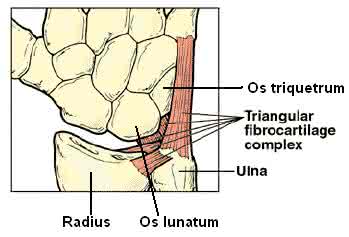TFCC Injury
What Is a TFCC Injury?

The triangular fibrocartilage complex (also called the TFCC) is a small piece of cartilage and ligaments on the little finger side of the wrist located just past the end of the forearm bone (ulna). Cartilage is a tough rubbery tissue that acts as a cushion for the joint. The ligaments are connective tissue that attach the cartilage to bones in the wrist.
How Does A TFCC Injury Occur?
A TFCC injury usually occurs by:
- 1. A fall onto the outstretched hand.
- 2. A direct blow to the little finger side of the wrist or hand.
- 3. Swinging a bat or a racquet.
- 4. A violent twist to the wrist at work or in sports.
What Are The Symptoms Of A TFCC Injury?
- 1. Pain on the little finger side of the wrist.
- 2. Clicking or catching when moving the wrist.
TFCC Injury Diagnosis:
Your doctor will examine your wrist and hand for tenderness at the little finger side of the wrist. There may be clicking or catching with movement of the wrist.
Your doctor may order an x-ray, an arthrogram (an x-ray done after special dye is injected into the wrist to outline the injured structures) or an MRI (magnetic resonance image).
Arthroscopy may be necessary to diagnose the tear.
TFCC Injury Treatment:
The early treatment of TFCC injuries include:
- 1. Protective support such as a TFCC brace or splint or a cast.
- 2. Ice for 20 to 30 minutes 3 to 4 times a day.
- 3. Anti-inflammatory medications such as Ibuprofen.
- 4. Wrist rehabilitation exercises.
- 5. An injection of a cortisone like medication.
A complete tear may require surgery. Many tears become painless with rest and time even if they don't actually heal.
TFCC Injury Recovery:
The goal of rehabilitation is to return you to your sport or activity as soon as is safely possible. If you return too soon you may worsen your injury, which could lead to permanent damage. Everyone recovers from injury at a different rate. Return to your sport or activity will be determined by how soon your wrist recovers, not by how many days or weeks it has been since your injury occurred. In general, the longer you have had symptoms before you start treatment, the longer it will take to get better.
You may return to your sport or activity when the injured wrist has full range of motion without pain. Your doctor may allow you to return to competition with your wrist taped or in a brace. Your injured wrist, hand, and forearm need to have the same strength as the uninjured side. There must not be any pain when you do activities such as swinging a bat or a racquet or tumbling in gymnastics. Use of a brace or splint may be required as determined by your physician.
How Can I Prevent A TFCC Injury?
Many TFCC injuries are caused by falls or blows that cannot be prevented. In racquet sports it is important to use good technique to prevent injury.
TFCC Injury Rehabilitation Exercises:
You may do stretching exercises 1 through 5 when the sharp wrist pain goes away. You may do strengthening exercises 6 through 8 when stretching is nearly painless.
1. Active range of motion:
A. Flexion: Gently try to bend your wrist forward. Hold for 5 seconds. Repeat 10 times. Do 3 sets.
B. Extension: Gently bend your wrist backward. Hold this position for 5 seconds. Repeat 10 times. Do 3 sets.
C. Side to side: Gently move your wrist from side to side, holding 5 seconds at each end. Repeat 10 times. Do 3 sets.
2. Stretching: With your uninjured hand, help to bed the wrist down by pressing the back of your hand and holding for 15 to 30 seconds. Next, stretch it backward by pressing the fingers in a backward direction and holding for 15 to30 seconds.
3. Wrist extension stretch: Stand at a table with your palms down, fingers flat, and elbows straight. Lean your body weight forward. Hold this position for 15 to 30 seconds.
4. Wrist flexion stretch: Stand with the back of your hands on a table, palms facing up, fingers pointing toward your body, and elbows straight. Lean away from the table. Hold this position for 15 to 30 seconds.
5. Pronation and supination of the forearm: With your elbow bent 90 degrees, turn your palm upward and hold for 5 seconds. Slowly turn your palm downward and hold for 5 seconds. Make sure you keep you elbow at your side and bent 90 degrees throughout this exercise. Repeat this 10 times.
6. Wrist flexion exercise: Holding a can or hammer handle with your palm up, bend your wrist upward. Slowly lower the weight and return to the starting position. Repeat 10 times. Do 3 sets of 10. gradually increase the weight of the can or weight that you are holding.
7. Wrist extension: Holding a can or hammer handle with your palm facing down, slowly bend your wrist upward. Slowly lower the weight down to the starting position. Repeat 10 times. Do 3 sets of 10. Gradually increase the weight of the object you are holding.
8. Grip strengthening: Squeeze a rubber ball and hold for 5 seconds. Repeat 10 times.
All material provided is designed for information purposes only and should not be used to replace the care of a health care professional. Do not rely on any of the information for diagnosis or treatment. It is recommended that you visit a qualified health care professional for individual and personal attention.